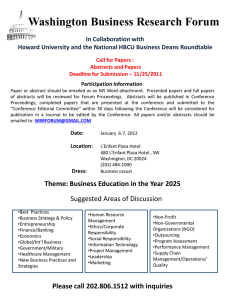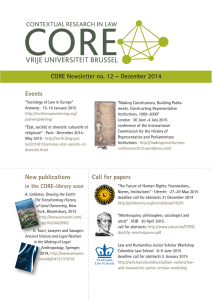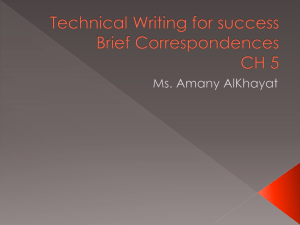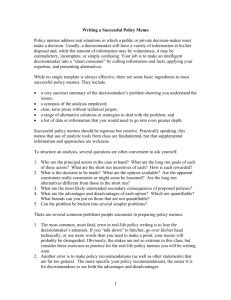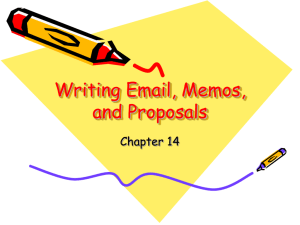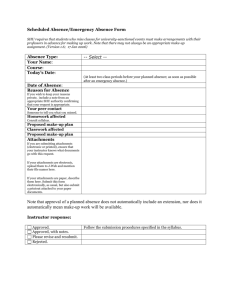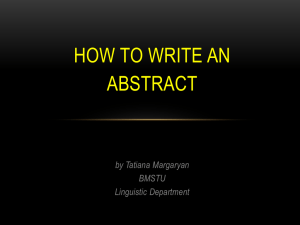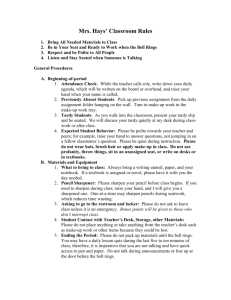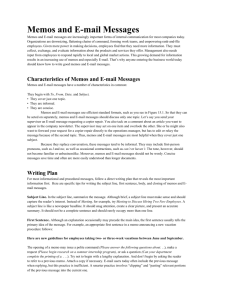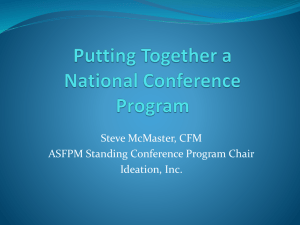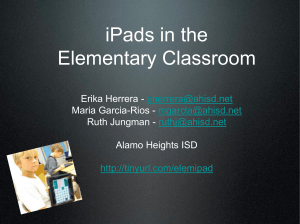ENGR 104: Intro to Engineering Lab
advertisement
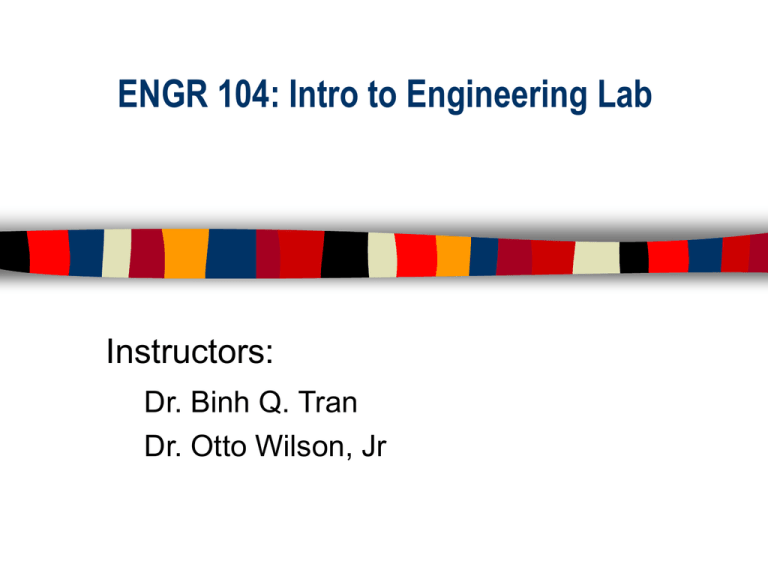
ENGR 104: Intro to Engineering Lab Instructors: Dr. Binh Q. Tran Dr. Otto Wilson, Jr Course Description/Objectives Description: In this class, students will apply mathematics and science principles to engineering problems. Objectives: Provide students with ability to understand and apply the fundamentals of mathematics and engineering; ability to make measurements on, and interpret data from systems; ability to work in teams to identify, formulate and solve engineering problems and challenges; ability to communicate effectively, in oral and written form; and ability to use modern engineering other tools for engineering practice. Grading Policy Homeworks Labs* (4) Quizzes (2) Participation 10% 60% (15% each) 20% (10% each) 10% Note: *ALL labs must be submitted to receive a passing grade. Syllabus Schedule Week Date Description Notes 1 8/31 2 9/07 Introduction to Course, Technical Writing & Other Tools Lab 1: The Beat Goes On-A 24-hour Study of Heart Rate Variability 3 9/14 Lab 1 (cont.) 4 9/21 Lab 2: Braveheart: "I am William Wallace!" Introduction to Projectile Motion 5 9/28 Lab 2 (cont.) Flight Data Collection-Field Work 6 10/5 Lab 2 (cont.) Flight Testing/Validation-Field Work 7 10/12 Quiz 1; Make up Session Open; Note: Monday (10/12) is Presidents Day; make-up: TBD 8 10/19 Introduction to Sensors & Actuators 9 10/26 Lab 3: Electronic Measurements Introduction to Sensors & Actuators Lab 3 (cont) 10 11/2 Lab 3 (cont) 11 11/09 12 11/16 Lab 4: Different Strokes for Different Strokes-Golf Analysis Lab 4 (cont.) Labview & Data Acquisition 13 11/23 Lab 4 (cont.) Putting Green-Field work 14 11/30 Quiz 2; Make-up Session Makeup 15 12/7 Open Open 16 12/14 Final Exam Period NO CLASS! We will be finished! Introduction to Statistics & Matlab Note: Monday (9/7) is Labor Day; make-up session TBD Introduction to Data Analysis and Presentation Intro to Labview & Data Acquisition Introduction to Technical Writing What is is. Technical writing is a style of writing for specialized areas of science and technology. Usually deals with objects, processes, systems or abstract ideas Tone is objective… accuracy of information is important, not style Goal: The goal of technical writing is to transmit technical information accurately and concisely. Types of Technical Writing. Proposals-Plan offered for acceptance or rejection. – Business plans, grant proposals, feasibility reports. Technical specifications-Description of work to be done intended to record the needs and requirements of a design or system and the process of evaluation. Technical articles, papers, abstracts, and reportsMedium through which engineers and scientists report about their work. – Abstracts: Short statement about the contents of a report, paper, or other document, usually 150-200 words or less. The abstract introduces the subject matter, tells what was done, presents selected results, and draws conclusions/makes recommendations. Types of Technical Writing Technical articles, papers, abstracts, and reports – Reports and Articles: Documents conveying results of research, field work, and other scientific activities. Letters, memos, and EMAIL-Routine correspondence. Address letters and memos to specific person and give title whenever possible. Keep letters and memos brief. End your correspondence by telling the reader what happens next. Manuals and documentation-Technical writing products that accompany systems produced by companies and giving instructions for use. Outline-Course Lab Reports Title of project Author names- Provide first, middle initial, and last names for each author. Abstract-150-200 words or less summarizing the entire contents of your work. Introduction-Describes purpose of the work, background, theory and explains why work was done. Presents the nature and scope of the investigated problem. Puts into perspective the importance of the work as it relates to scientific/engineering knowledge. Discuss findings from previous research and other pertinent literature. Outline-Course Lab Reports (cont) Methods-Contains the detailed theory behind the work, outlines the equipment, apparatus, and procedures used to conduct the work with sufficient detail so that other researchers can duplicate the work if necessary. Results-Presents experimental data, results, and observations, with brief discussion of unusual data. Discussion and Conclusions-Presents discussion of data and how they compare with results achieved by theoretical computations/expectations, other researchers, etc. Draws conclusions from the experimental work. Good Technical Writing Guidelines: Be Technical Acccurate Be Useful Be Concise Be Complete Be Clear-Use Visuals when appropriate Be Consistent Be Careful Visuals and What They Say Visual What It Shows Photograph or drawing What something looks like Map Where it is located Diagram How it is put together Flow chart/block diagram How it works Graph How one variable changes in relation to another Pie Chart Proportions or percetnages Bar Chart Comparisons among quantities Table Body of Data Structured diagram Components of a system and how they interrelate Tools of the Trade Word Processing Spreadsheets Presentation
